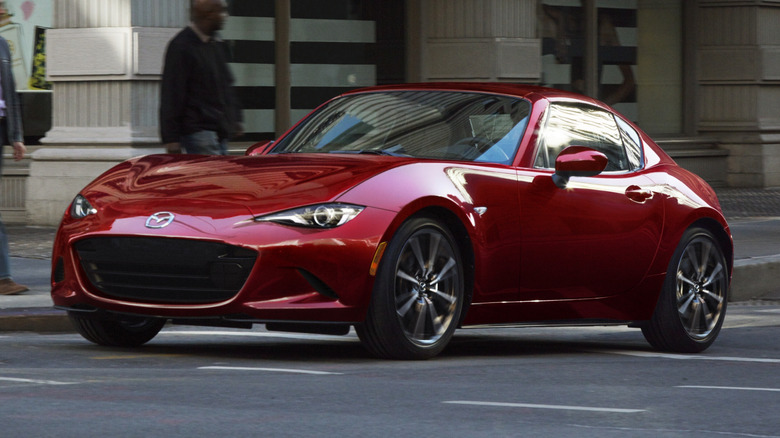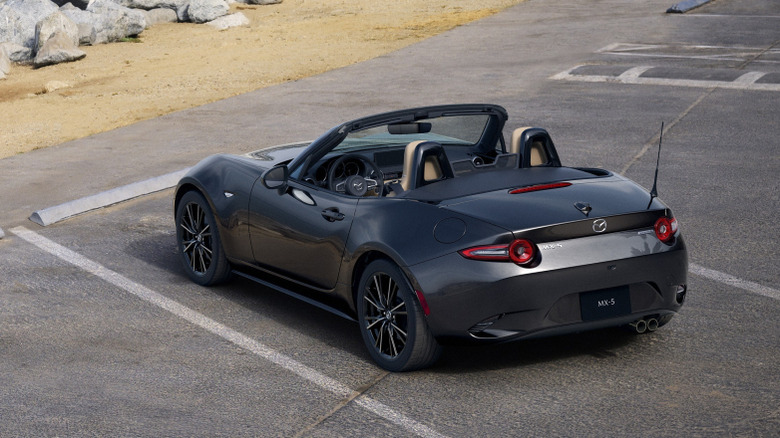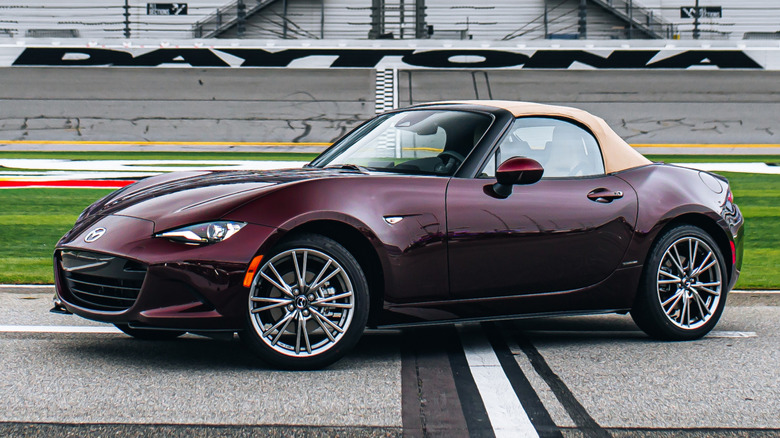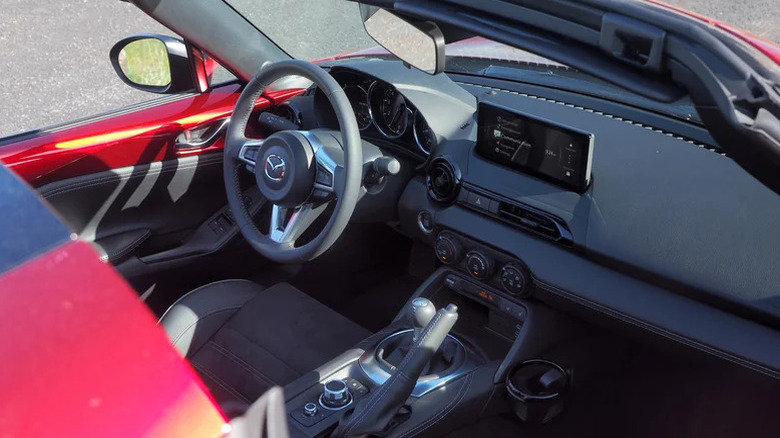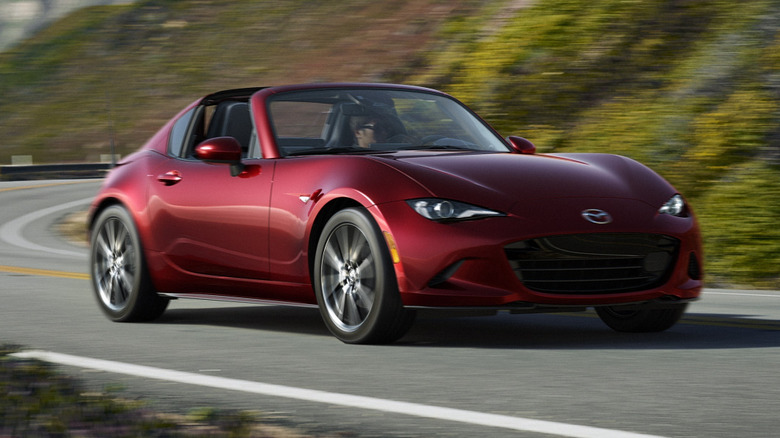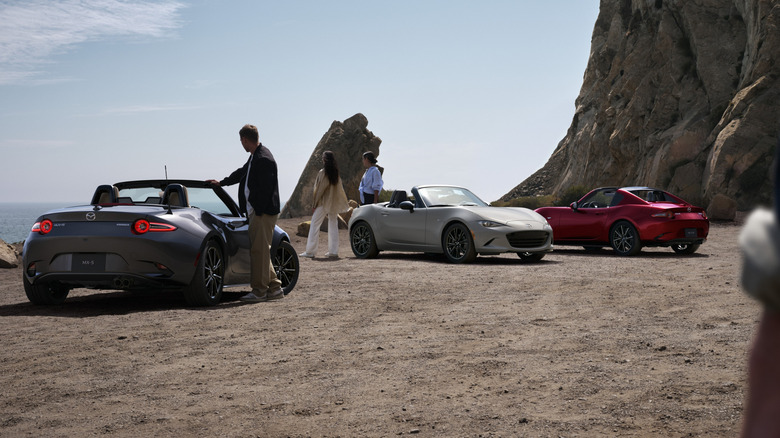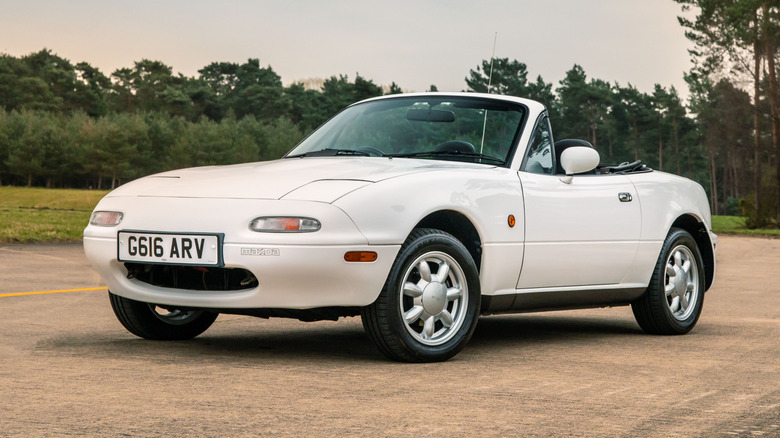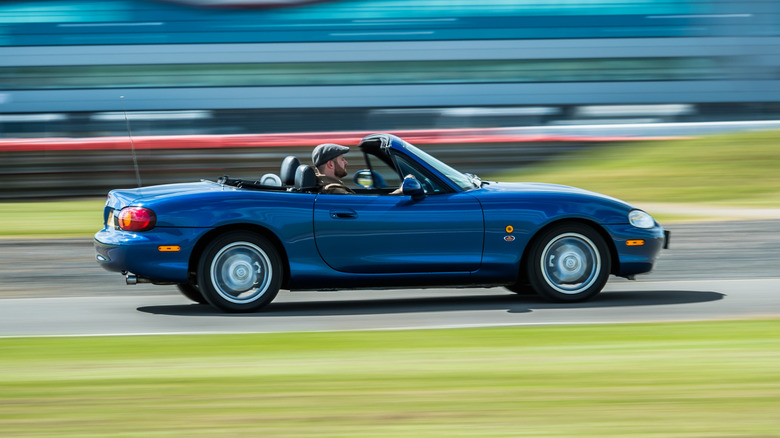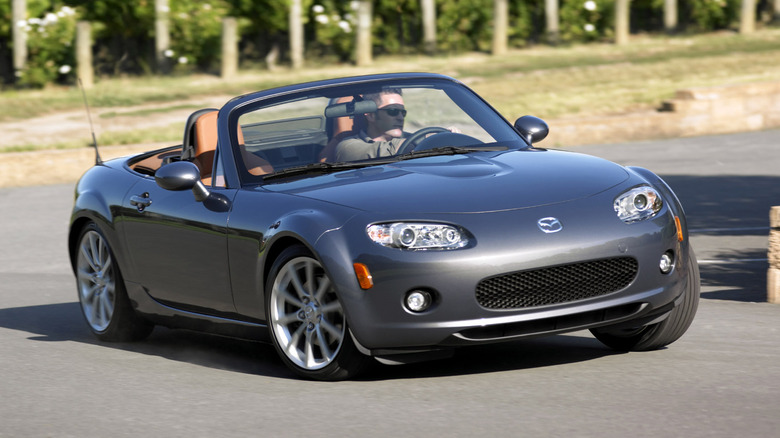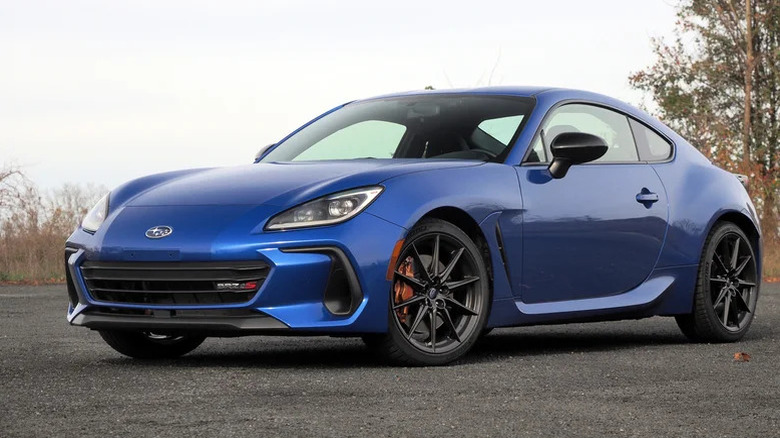10 Things To Know Before Buying A Mazda MX-5 Miata (New Or Used)
In multiple ways, the Mazda MX-5 is a rare breed. It's a small, lightweight sports car that's still offered with a manual transmission, which is rare enough in itself. It's also temptingly affordable for enthusiasts, and has a reputation for being reliable. Assuming you didn't need the extra space for passengers or cargo, it could feasibly be used as a daily driver. With one or two notable exceptions, that's a combination of attributes that simply isn't offered anywhere else on the modern car market.
As a result, Mazda doesn't have to overhaul the Miata every year or cram it with all the latest new features in order for it to be appealing. Its core formula is a winner, but there are still a few things that potential Miata buyer should consider. Things like whether a new or used example is a better bet, or if you should go for the traditional roadster or folding hardtop RF. There's no one-size-fits-all answer to those questions, but to help you make those decisions yourself, we've put together a roundup of things to consider before you head to a dealership.
The Miata starts from around $30,000 for 2025
It's no longer possible to buy a brand new Miata for under $30,000. The base-spec Sport roadster starts from $29,530 and is subject to a compulsory destination fee, which is $1,230 in Alaska and $1,185 everywhere else. Still, a base-spec Miata roadster is only a few hundred dollars over that $30,000 threshold, and it's still well worth considering. Buyers get Apple CarPlay and Android Auto integration as standard, alongside safety features like blind spot monitoring. All trims receive the same 181 horsepower 2.0L engine.
Step up to the roadster's Club trim, which starts from $33,030 excluding fees, and you get extras like a Bose audio system and revised sports suspension. For another $1,800, the Grand Touring trim offers heated leather-trimmed seats and built-in navigation. The priciest trim for the 2025 roadster is the 35th Anniversary Edition, which is discussed in more detail below.
The Miata RF, with its folding hardtop roof, adds an extra layer of everyday practicality. However, it comes at a significant cost: the cheapest RF trim is the Grand Touring, which starts from $37,550 excluding fees, while the top-spec Club trim will cost at least $40,850 plus fees.
A new 35th Anniversary Edition launches for 2025
Mazda tends not to make drastic changes between Miata model years, and 2025 is no different. The biggest change is the launch of the 35th Anniversary Edition, which tops the Miata roadster lineup with a starting price of $36,250 excluding fees.
This special edition features a suite of unique aesthetic tweaks, including a beige soft top roof, Artisan Red paint, and a tan-colored Nappa leather interior. Various badges and emblems are dotted around the car with 35th Anniversary Edition branding. No mechanical changes have been made to the car. It's limited to a maximum of 300 units, with Mazda promising a "special ownership experience" to those who order.
Within the standard Miata range, the only other change for 2025 sees the Deep Crystal Blue paint option now available on the Grand Touring trim. The launch of the 2024 model saw a more notable set of tweaks, with updated steering, a new, larger touchscreen, and a new limited-slip differential launched.
We love the MX-5 Miata's handling
At risk of stating the obvious, the MX-5 Miata is great fun to drive. It's safe to assume that anyone considering a Miata will already be well aware of this, but even so, it's worth pointing out that Mazda didn't have to make the car as good as it is. No electrification, a manual transmission, and a modest power output all fly in the face of current market trends, but that's exactly why it's worth buying.
Our 2022 review of the current generation Miata called the manual transmission "sublime," while in 2023, our reviewer noted that driving the latest model back-to-back with a 1999 example highlights how remarkably well Mazda has kept the classic sports car feel throughout the generations. In 2024, we spent some time with the pricier folding hardtop roof Miata RF, and found its added practicality to more than justify its higher price.
The Miata is no gas guzzler
As well as being a blast on the roads, the Miata is also impressively economical thanks to its 2.0L engine. The 2025 model is available in both manual and automatic, with the EPA's combined rating for both sitting at 29 mpg. Both are just as economical in the city too, achieving 26 mpg, but on the highway, the automatic Miata has the slight edge, achieving 35 mpg to the manual's 34 mpg. Of course, this tiny difference will be irrelevant for most enthusiasts, as they'll be buying the Miata for its excellent manual transmission anyway, regardless of efficiency.
The EPA estimates that the manual Miata will cost $2,000 more to fill up than the average new car over the course of five years, based on an annual mixed mileage of 15,000 miles. In sports car terms, that's still pretty impressive — a manual Nissan Z, for comparison, will cost $6,750 more than average over the same period.
Mazda has sold well over one million Miatas
In 2016, Mazda announced that it had built the one millionth Miata at its Ujina Plant No. 1 in Hiroshima, Japan. That was enough to make it the best-selling two-seater roadster in the world. The Miata's sales figures in America have fluctuated over the last few years, with 2022, 2023 and 2024 seeing a dip in demand after a peak in 2021.
Over the past two decades, Mazda has sold over 178,000 examples of the Miata in the U.S. alone, which is great news for used car buyers. It means there will be plenty of inventory out there to pick from no matter what generation or model year they're considering. Over that period, 2006 and 2007 saw the highest level of American Miata sales, with almost 17,000 examples sold in 2006 and over 15,000 examples finding homes in 2007. In 2024, the most recent model year for which there is sales data, total figures dropped to 7,489.
The Miata first launched in 1989
To date, the Miata has been through four generations, with the first of those launching back in 1989. The NA generation Miata proved to be a hit from the get-go, with its modest power output and light weight chassis distinguishing it from the crowd. The roadster remained in production for around a decade, until the NB generation launched for the 1999 model year. Mazda didn't mess with the core formula, but it did unveil a few spin-off variants of the car, including the Japan-only Roadster Coupe which remains one of the rarest Mazdas ever made today.
The third (NC) generation arrived in 2005, and was the first to feature a folding hardtop model. Then, in 2014, Mazda took the covers off the fourth and current ND generation Miata. The hardtop option returned for the 2017 model year with the launch of the Miata RF. While the current generation Miata has already become the longest-lived generation to date, Mazda hasn't revealed any immediate plans to replace it. However, the first details are beginning to emerge about its eventual successor, and it looks like enthusiasts will be pleased. You can find more on those details below.
All model years remain generally trouble-free
Unlike many used cars, there's no one model year of the Miata that's worth avoiding — they're all safe bets for used buyers as long as they remain aware of the general red flags to look out for. The model year with the highest level of owner complaints in NHTSA data is the 1999 model, which has 75 complaints recorded as of this writing. That's still a low number overall, but it's almost double that of the next most complained about model, which has racked up a mere 35 complaints.
The complaints recorded about the 1999 model don't point to any one problem with that particular model year, instead they mostly relate to general issues with older Miatas. Most can be avoided by checking all the usual things you should look for when buying any used car. Among other things, these include signs of rust — particularly any rust that appears to have been hastily covered up — and signs that fluids have been replaced regularly. Miatas are also popular cars to modify, so be wary of any cars with poorly installed modifications, particularly engine mods, as they can cause premature wear on other components and lead to big repair bills later down the line.
Every generation remains affordable to buy today
No matter whether you're looking for a lightly used example that's a few years old or a classic from the early days of the nameplate, the Miata remains an affordable choice across every generation. Newer, lower mileage ND generation cars will naturally command a premium, but they're arguably the best choice for anyone looking to rely on their car for everyday duties or cover significant mileage in it.
The NA is arguably the best generation for retro looks, although cleaner examples are getting considerably harder to find than they once were. This is reflected in their pricing, with the most pristine examples of the NA generation now regularly fetching $20,000 or more at auction. However, average prices for the generation remain low. Be particularly wary of hidden rust in suspiciously cheap examples.
The NB and NC generations are both great bets for buyers looking for driving fun on a budget, since less pristine examples of both can be picked up for under $10,000. The NB has the lower average sale price of the pair, and offers a similarly classic look to the NA.
The Miata doesn't really have much competition
Aside from Toyota and Subaru's BRZ and GR86 twins, there isn't really anything else on the current new car market that directly rivals the Miata. In top-spec form, the Miata's price isn't that far off a Nissan Z, but the Z is a different kind of car. While the Miata is a lightweight, modestly powered sports car, the Z is closer to an old-school muscle coupe, with 400 horsepower on offer from its burly twin-turbo V6 engine.
While the Subaru BRZ — and by extension its Toyota-badged GR86 counterpart — is similarly affordable to the Miata, it doesn't offer the same open-top thrills. There's also the Toyota GR Corolla, which starts from around the same price as a top-spec Miata RF. It, too, offers driving thrills by the bucket load, but with more power, more grip, and at a higher price than the Miata. Other, roomier enthusiast-oriented cars like the Honda Civic Si are also available, but none offer the same open-top, pure-bred sports car experience as the Mazda.
Details are starting to emerge about the next-generation Miata
Mazda has not yet announced when it plans to replace the ND Miata with a new generation, nor has it announced exactly what an updated car might look like. However, Car and Driver spoke with several Mazda executives in Japan in early 2025 and came away with reassurances that should please enthusiasts. The first is that Mazda still intends to keep the Miata as lightweight as possible, while preserving the manual transmission/combustion engine combination.
The report notes that both electric and gas-powered versions of a new Miata are being considered, but Mazda's preference still remains for the car to stick with combustion power. There may also be room in the brand's lineup for a larger sports car, although for now, no concrete plans have been unveiled to develop one. While it seems inevitable that one day the Miata will have to incorporate some form of electrification, at least if Mazda wants to keep selling it around the globe, for now at least it seems the car's core formula will remain unchanged.
